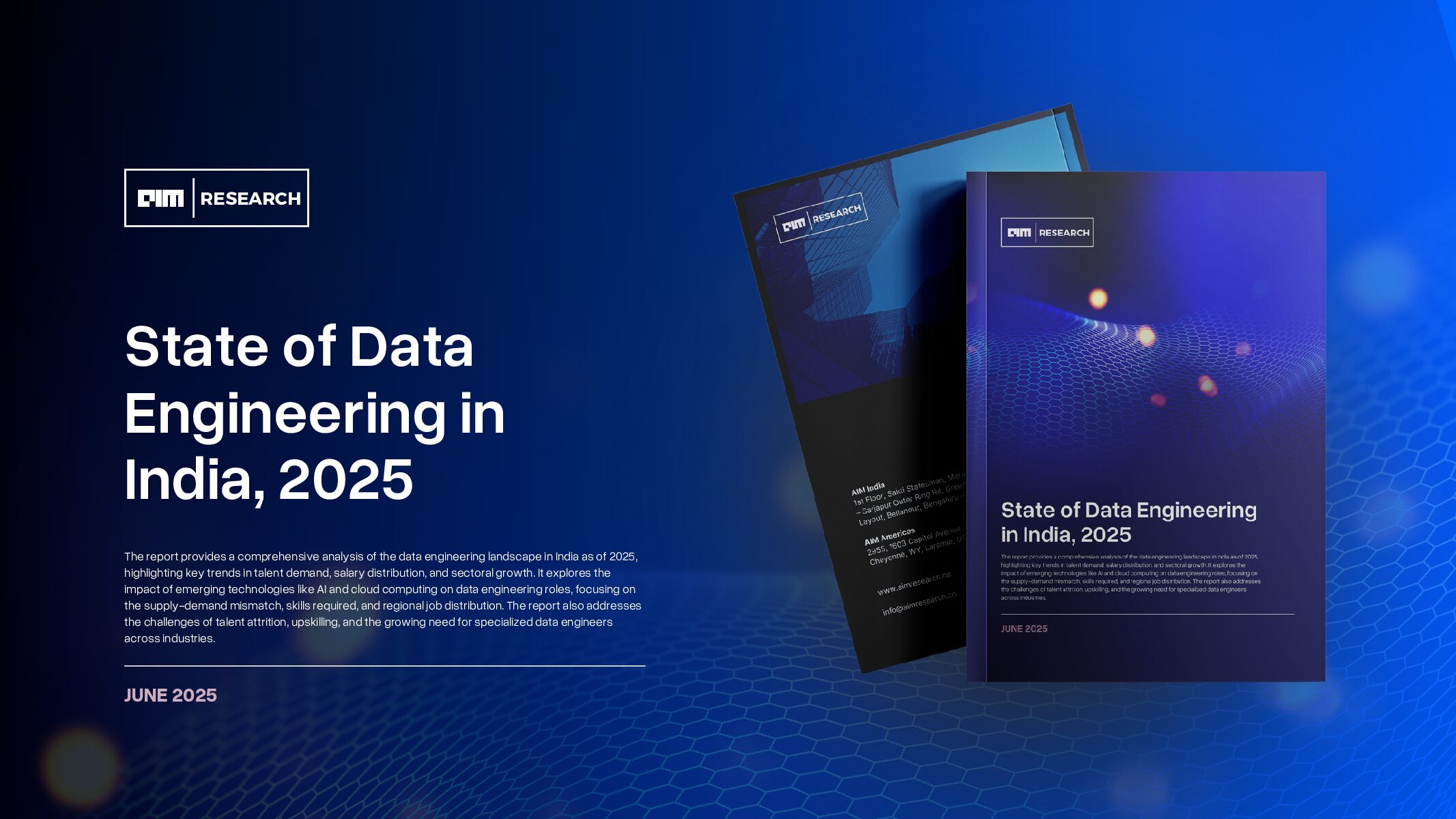This week’s CDO Insights features Junaid Farooq, Senior Vice President of Enterprise Data Management at an esteemed bank. With a wealth of experience gathered from prominent roles at institutions such as S&P Global Ratings, Investment Bank, PWC, and Hedgeserv, Junaid Farooq brings a rich background to the discussion. A graduate of Rutgers, The State University of New Jersey-Newark (1992 – 1996), Junaid possesses a robust skill set encompassing Capital Markets, Master Data Management, Data Analysis, Machine Learning, Agile Methodologies, and more. Leveraging his diverse expertise, Junaid Farooq offers invaluable insights to the industry, enriching discussions on data-driven strategies and innovations.
AIM Research: We’ve heard the term data democratization described differently, could you tell us what it means to you and how you define it?
Junaid Farooq: In the landscape of data-driven decision-making, the concept of data democratization emerged as a pivotal force reshaping organizational strategies. Its most common definition is often limited to making data more accessible to non-technical users. However, for data democratization efforts to be successful, the definition should be expanded to include several other components.
True data democratization encompasses a multifaceted approach that involves not only providing access to data but also the deployment of tools and technology which enables data access, fostering a data driven culture, enabling data literacy, and implementing robust data governance measures. Therefore, the description of data democratization is expanded to include the process of establishing a data-driven culture that makes data accessible to all professionals (including non-technical users), through the deployment of technology and tools that make access to the data easier and that capture meaningful metadata (business, technical & operational).
Establishing a data-driven culture and a data literate organization are often not included in democratization efforts. When data professionals are enabled through persona-based data literacy curriculums / campaigns, they are better able to identify business value propositions, while effective and efficient data governance programs ensure that data remains secure and that it is fit for purpose.
This holistic view defines data democratization as the establishment of a data-driven culture predicated on data literacy, where all professionals, regardless of technical expertise, can access well governed data through user-friendly tools and comprehend that data through robust metadata strategies.
AIM Research: Data democratization has been discussed for a while. Why is it an essential component of any data strategy? Why is gaining such rapid and widespread adoption right now? What’s changed to make it so accessible?
Junaid Farooq: The reason that this topic is now more relevant than ever and why there is so much traction is due to the intersection of several primary events. The first is the incredible amount of data that is being created at an exponential rate. This abundance of data means there’s more information available for analysis and decision-making purposes. The second is the tremendous technological advancements: With advancements in technology, particularly in cloud computing, big data processing, and analytics tools, it’s become easier and more cost-effective to store, process, and analyze large volumes of data. This has lowered the barriers to entry for organizations of all sizes to access and utilize data. The third is the cultural shift towards data literacy and the availability of more data professionals than ever before. The increasing volume and complexity of data generated by organizations, coupled with the growing recognition of the value of data-driven decision-making, have led to a surge in demand for data professionals across various industries.
In today’s competitive landscape, businesses are recognizing the value of data-driven decision-making. By democratizing data and empowering employees at all levels with access to data and analytics tools, organizations can foster a culture of data-driven decision-making, leading to better insights and outcomes.
AIM Research: Data is no longer just for the analysts and IT experts. How is data democratization impacting decision-making for employees across various departments and levels of seniority?
Junaid Farooq: Data democratization is profoundly impacting decision-making across all levels of an enterprise. Improved data literacy, when combined with accessible data, not only facilitates decision-making but also accelerates it. Streamlining data access by reducing bottlenecks, approvals and bureaucratic hurdles associated with accessing data, and putting analysis in the hands of the professionals through powerful technology leads to accelerated and more informed decision-making.
Information and insight are amplified by providing data to a diverse range of consumers. The facilitation of cross-functional collaboration breaks down silos between departments and functions by providing a shared platform for accessing and collaborating on data. This cross-functional collaboration enables a more holistic understanding of business challenges and opportunities, leading to more informed and coordinated decision-making.
Decision making is not only improved by being able to make accelerated and more informed choices, but the democratization also improved the agility in the decision making process. With access to real-time or near-real-time data, decision-makers can respond quickly to changing market conditions, customer preferences, and competitive threats. This agility enables organizations to adapt their strategies and tactics more effectively, staying ahead of the curve in dynamic business environments.
AIM Research: It has been said that data democratization impacts organizational culture. Can you speak to the ways that this phenomenon might be transforming how companies and teams operate?
Junaid Farooq: It is important to note that data democratization is not a software or a tool that you buy. It is a mindset and a way of thinking that leads to a belief system of how data should be managed. At its core is a cultural movement that promotes transparency, collaboration, and informed decision-making at all levels. It shifts power away from centralized data teams or individuals and empowers employees across the organization to access and interpret data for themselves. This fosters a culture of data-driven decision-making, where insights are valued over hierarchy, and innovation flourishes.
The impact to organizational culture of data democratization should not be understated and I would argue that it is essential to any data strategy. There are many cultural impacts, but in my opinion the most notable increased collaboration, empowerment and transparency. Collaboration becomes more fluid and dynamic, as individuals share insights, ideas, and best practices, leading to more effective problem-solving. Data democratization empowers employees by giving them the tools and information they need to make informed decisions independently. This reduces reliance on centralized decision-making and hierarchical structures, empowering teams to take ownership of their work and drive results. Transparency increases as data becomes more accessible throughout the organization. Teams have visibility into performance metrics, goals, and objectives, fostering a culture of accountability and trust.
AIM Research: With increased data access comes heightened concerns about privacy and ethical implications. How can we ensure that data democratization happens in a responsible way, safeguarding individual privacy and upholding ethical standards?
Junaid Farooq: While data democratization offers many benefits, it also presents some concerns and challenges. Most of these concerns will center around data security, data privacy, data quality, training, and information overload.
It is essential to have data governance that is mature, noninvasive, yet effective. Striking a balance between governance that is both robust and not burdensome is key, with an emphasis on the following capabilities:
- Security/Access: Ensuring robust security measures to decrease the risk of data breaches, unauthorized access and ensure compliance with regulations like GDPR is essential to protect sensitive information.
- Meta-Data Management: It is not only important to have access to the data to make informed decisions, but having the descriptive information that provides context, structure, and meaning to data is essential.
- Data Quality: Establishing data quality practices is crucial to maintain data integrity, to mitigate inconsistencies and inaccuracies in data leading to flawed analyses and decision-making.
- Data Literacy& Training: Not all employees may have the necessary skills to effectively analyze and interpret data. Providing adequate training and support is essential to ensure that users can derive meaningful insights and make informed decisions.
AIM Research: Data democratization can spark innovation and creativity. How can organizations leverage this phenomenon to unlock new possibilities and gain a competitive edge?
Junaid Farooq: Data in isolation has limited value. The true power in data analysis lies in accessing disparate data sets, establishing relationships between them, then interpreting and deriving value from their correlations. This kind of deep analysis in a collaborative environment unlocks meaningful and actionable insights.
One of my favorite aspects of data democratization is that it encourages experimentation and creativity by enabling professionals to explore and analyze data. This fosters a mindset of innovation, where employees are empowered to test new ideas, identify opportunities, and iterate based on data-driven insights.
Data democratization enables more minds to engage together on innovative solutions and challenges. They can leverage diverse interpretations and insights that would otherwise remain untapped. This inturn allows organizations to unlock tremendous potential value.
The importance of a data democratization strategy in today’s business landscape cannot be overstated. It’s about more than just accessing data and breaking down silos – it’s about ushering in a culture of transparency, empowerment, and continuous growth. Organizations that recognize and embrace this transformative shift are not just staying relevant, they’re carving a path towards more informed decision making, faster innovation and increased competitiveness.
AIM Research: Can you share a specific example of how data democratization is being implemented in a real-world scenario, and what are the tangible benefits it’s yielding?
Junaid Farooq: I once worked at a research company that produced intellectual property and media content, among other things. They derived their revenue from subscription fees for their content and research products. They had a wonderful offering, but their marketing and sales process to new customers was inefficient and they had challenges cross selling and upselling to existing customers. This was due to a myriad of reasons. But the four primary reasons was that
1) there was no common enterprise definition of a customer. For example, a salesperson described a customer as the person who bought a subscription, while someone in the accounting department would describe the customer as the institution where the person worked, as the institution paid the invoices for the subscription. With such a divergence on lexicon, we could not answer very basic questions like how many customers do we have.
2) because of an antiquated data model, there was a disjointed view of holding companies and conglomerates, leading to a very narrow view of the customer. For example, in some cases there was a view of Amazon, Whole Foods and Zappos as three different companies rather than seeing them as one with Amazon being the parent company. In other cases, there was a flat organizational view showing subsidiaries of whole foods and subsidiaries as child companies of Amazon instead of seeing the full legal entity structure for each institution. This impacted the firms go to market strategy as sales teams often had overlapping sales campaigns to the same enterprise. In some cases, salespeople were attempting to sell products to a subsidiary that were already owned by the enterprise. This redundancy resulted in a negative client experience as well as an inefficient sales process.
3) there was an ambiguous contact relationship model, meaning that they could not easily distinguish between roles such as a subscriber who consumed the content, a person responsible for paying for the subscription or the person who was a decision maker in approving the subscription. This ambiguity impacted the ability to cross an upsell because we couldn’t always tell what products a client had.
4) there was a lack of controls and process leading to an overly complex data journey when onboarding customers and unclear data ownership as it related to maintaining it. Customer data was created through a number silo’d systems and processes (i.e marketing systems, sales, product management, accounting, etc…). There were no common standards and there was no discipline in which business and information technology work together to ensure the uniformity, accuracy, stewardship, semantic consistency and accountability of the enterprise’s customer data. This impacted functions across the enterprise from marketing to accounting.
To summarize the above through the lens of data management, we did not have a shared metadata strategy where we could establish a common language around customer data. Our data architecture did not support a multitiered data model to appropriately view the hierarchical structure of large enterprises, and it did not allow us to comprehensively capture relationship types without creating duplicative data. Technology ecosystems and therefore data was siloed. There were multiple points of creation for customer data and there was no master data management program to establish a unified view of the client. These problems were amplified because with the technology silo’s, came people silos. Business stakeholders did not have access to applications outside of their ecosystems. Data literacy was limited, with most had only a rudimentary knowledge of data disciplines such as meta data or master data management. They all did agree that data quality was poor, and while they couldn’t articulate what a good data quality framework would look like, they could articulate what would make their data “fit for purpose”.
Following the spirit of how I defined data democratization, we endeavored to implement a data driven culture by establishing a customer data strategy committee that had representation from across the enterprise. This includes professionals from marketing, sales, client operations (onboarding, KYC specialists, customer support), accounting, and information technology partners. With this cross organization participation we are able drive enterprise alignment on our metadata strategy, which includes building a data catalog to establish a common language around the domain and drive data lineage to understand the life cycle of data, tracking its origins, movements, transformations, and interactions across various systems and processes. We additionally made data accessible to all the key stakeholders while ensuring permissions to systems and datasets were thoughtful and controlled. With the consortium of stakeholders, we are able to re-define our customer data model to meet hierarchical and relationship needs that are nuances for the domain. We also revisited the overall data architecture to allow for a successful implementation of a master data management to drive a single source of truth for Customer Data. A robust and domain specific data governance & quality program was implemented, that included notable and specific involvement from customer data producers and consumers to ensure that data quality standards were met. Lastly, a data literacy campaign was launched to empower stakeholders to ask the right questions, build knowledge, and make decisions.
By doing all of this we embodied the essence of data democratization. We established a data-driven culture that makes data accessible to all professionals through the deployment of technology and tools that make access to the data easier and that capture meaningful metadata. We empowered professionals with data literacy curriculums so they are better able to identify business value propositions, while effective and efficient data governance programs ensure that data remains secure and that it is fit for purpose.























